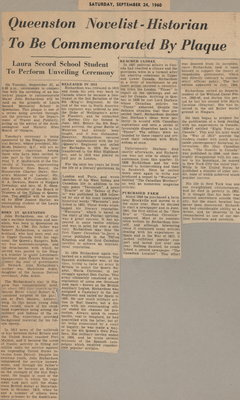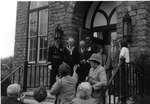Queenston Novelist - Historian To Be Commemorated By Plaque.
- Publication
- Niagara Falls Review, 24 Sep 1960
- Full Text
LAURA SECORD SCHOOL STUDENT TO PERFORM UNVEILING CEREMONY
On Tuesday, September 27, at 3.30 p.m., ceremonies in connection with the unveiling of an historical plaque to commemorate Major John Richardson will be held on the grounds of Laura Secord Memorial School in Queenston. This plaque is one of a series being erected throughout the province by the Department of Travel and Publicity, acting on the advice of the Archaeological and Historic Sites Board of Ontario.
Tuesday's ceremony is being sponsored by the Niagara Historical Society, whose president, Mr. Brian Doherty, Q.C., will act as programme chairman. Among those who have been invited to take part in the ceremony are: Prof. T. F. McIlwraith of the University of Toronto, representing the Historic Sites Board; the Honourable Charles Daley, Ontario's Minister of Labour; Mr. John Smith, M.P. (Lincoln); Mr. H. A. Dawson, Reeve of Niagara Township; and Mrs. M. E. Sheppard, a member of the Board of Trustees of the Village of Queenston. The plaque will be unveiled by Miss Joanne Haylor, an outstanding student of the Laura Secord School.
BORN IN QUEENSTON
John Richardson, one of Canada's earliest historians and novelists, was born in Queenston on October 4, 1796. His father was Robert Richardson, a native of Scotland, who had been sent out to Upper Canada with his regiment, the Queen's Rangers. Robert was assistant-surgeon, and the detachment with which he served was posted to the Niagara frontier to assist Lieutenant-Governor John Graves Simcoe to protect the seat of government at Newark. John Richardson's mother was Madelaine Askin, daughter of the famous Detroit merchant, John Askin.
The Richardson's stay in Niagara was comparatively brief, for about 1802 they moved to Detroit River where Robert was appointed surgeon to the garrison at Fort Malden, Amhersburg. In this locale young John was raised, much of his childhood experience being among the military and Indians of the region. This experience provided background material for his future novels.
In 1812 news of the outbreak of war between Great Britain and the United States reached Fort Maiden, and it became the scene of frantic activity in fitting out militia units for service against an impending United States invasion from Detroit. Despite his extreme youth, John Richardson volunteered for service immediately, and through his father's influence he became an Ensign on the strength of the 41st Regiment. He fought in most of the engagements in which the regiment took part until the disastrous British defeat at Moraviantown in October, 1813, when he and a number of others were taken prisoner by the Americans.
RELEASED IN 1814 n
Richardson was released in 1814 and made his own way back to Canada where he became a lieutenant in the 2nd Battalion of the 8th (King's) Regiment. At the end of the war in North America his regiment was ordered to join the Duke of Wellington's army in Flanders, and he embarked at Quebec City for Ostend in June, 1815. Before the 8th Regiment arrived, the great Battle of Waterloo had already been fought, and it was disbanded. However, Richardson secured another appointment with the 1st (Queen's) Regiment and sailed for Barbados in 1816. He later transferred to the 92nd Highlanders, and in 1818 was placed on half pay in London.
For the next ten years he lived the life of a literary gentleman in London and Paris, and wrote sketches of his West Indian and Canadian life in addition to the epic poem "Tecumseh". A novel "Ecarte" or the "Salons of Paris" was published in 1829 followed by one of his most celebrated historical works "Wacousta", published in 1832. These works established his literary reputation. "Wacousta", which is based on the story of the Pontiac uprising, was a great success. It has appeared in some twelve editions and was in print for over a century. Richardson is thus the first Upper Canadian to have a verse published in the United Kingdom and the first Canadian novelist to achieve an international reputation.
In 1834 Richardson again embarked on a military venture. The Spanish Ambassador was, at the time, trying to raise an army in Britain to assist the Queen Regent, Maria Christian, in her struggle against Don Carlos. This army ultimately consisted of ten regiments of some one thousand men each - known as the British Auxiliary Legion. Richardson was assigned a Captaincy in the 2nd Regiment and sailed for Spain in 1835. He saw much military action in that theatre, but a dispute with his commanding officer ended his chances for promotion. Always quick to resent insults, real or imagined, he had quarrelled with the latter, but after being exonerated by a court of inquiry, he was made a major in the 4th Queen's Own Fusiliers. His military service ended in 1836, and he wrote several accounts of the Spanish campaigns which received considerable popular acclaim.
REACHED CLIMAX
In 1837 political affairs in Canada had reached a climax and the provinces were in a turmoil after the abortive rebellions in Upper and Lower Canada. Richardson in a fever of excitement to see more action secured a commission from the London "Times" to report on the uprisings and set sail for Canada. Arriving in Quebec in 1838 he met Lord Durham whose Canadian policies the "Times" abhorred. Despite the delicate situation that thus presented itself, Richardson decided that Durham's ideas were perfectly in accord with Canadian aspirations and sent a series of favourable dispatches back to the "Times". The editors were astounded by these reports and severed their relations with Richardson at once.
Unfortunately Durham died shortly afterwards, and Richardson was not able to obtain any assistance from this quarter. In 1838 Richardson and his wife moved to Amherstburg and then to Sandwich. Here he settled down once again to write and produced a sequel to "Wacousta" entitled "The Canadian Brothers" as well as numerous magazine "articles.
PURCHASED FARM
About 1840 he purchased a farm near Brockville and moved to it the same year. Here he decided to start a newspaper and in June, 1841, the first edition of the "New Era" or "Canadian Chronicle" appeared. Most of its contents were written by Richardson himself, and although interesting since it contained many articles dealing with his experiences in Spain and in the War of 1812, it lacked sufficient popular support and lasted just over one year. Nothing daunted, he established a second newspaper "The Canadian Loyalist". This effort was doomed from its inception, since Richardson took it upon himself to support the theory of responsible government, which was directly contrary to contemporary official policy. The last edition appeared in July, 1844.
Richardson served as Superintendent of the Welland Canal Police. 1845-46, and during this period he lost his second wife Maria Caroline (Drayton). She was interred in the old Butler burial ground at Niagara.
He then began to prepare for, the publication of a book dealing with his experiences in Canada, 1838-47 entitled "Eight Years in Canada". This and his later work the "War of 1812" provide the modern reader with much invaluable contemporary historical information. His final Canadian work, "The Guards in Canada" was published in 1848, and thoroughly disappointed with his career in his homeland, he moved to New York City the same year. While in the United States he published a number of other novels, none of which achieved much popular success.
His life in New York was one straightened circumstances, and he died in poverty in 1852. It is thought that his body was interred somewhere outside that city, but the exact location has never been discovered. Richardson had considerable ability as a writer, and he deserves to be remembered as one of our earliest historians and novelists.
- Roels, Ron, Photographer
- Media Type
- Text
- Image
- Item Type
- Clippings
- Description
- Article about unveiling a plaque dedicated to Major John Richardson on the grounds of Laura Secord Memorial School in Queenston.
The ceremony took place on Sep 28, 1960 and additional photos were published after that. - Place of Publication
- Niagara Falls, Ontario
- Date of Publication
- 24 Sep 1960
- Date Of Event
- 27 Sep 1960
- Subject(s)
- Local identifier
- QC00200 QC00201
- Language of Item
- English
- Geographic Coverage
-
-
Ontario, Canada
Latitude: 43.16682 Longitude: -79.04957
-
- Donor
- Huggins, Jean A. E. (1895-1989)
- Copyright Statement
- Public domain: Copyright has expired according to Canadian law. No restrictions on use.
- Contact
- Niagara-on-the-Lake Public LibraryEmail:localhistory@notlpl.org
Website
Agency street/mail address:10 Anderson Lane P.O. Box 430
Niagara-on-the-Lake, ON L0S 1J0
905-468-2023




